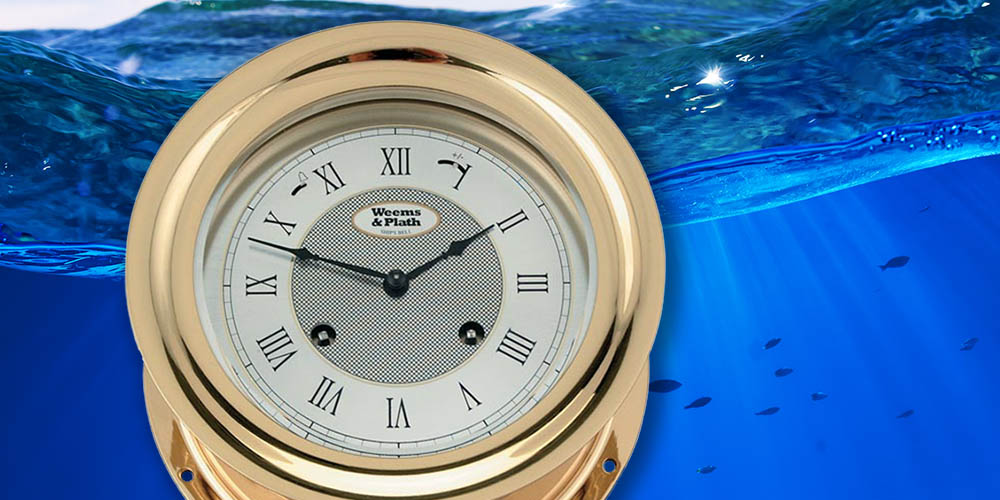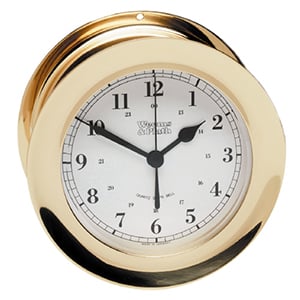

The Atlantis 8-Day Wind Ship's Bell Clock can be mounted to a bulkhead or displayed on a desk or mantel with the optional Mahogany Base.
Striking clocks use the traditional ship’s bells. The following is taken from Chapman’s standard reference book, Piloting, Seamanship and Small Boat Handling:
Ship’s bell time originated in sailing ship days, when the crew of a vessel was divided into Port and Starboard Watches, each on duty four hours, then off four hours. One stroke of the ship’s bell indicates the first half hour of the watch. Then an additional bell is struck for each succeeding half hour. Thus eight bells indicates the end of a four-hour watch. When the time calls for two or more strokes, they are sounded in groups of two.
The first five watches are as follows:
- First Watch, 8pm to Midnight (20:00 to 00:00 hours)
- Middle Watch, Midnight to 4am (00:00 to 04:00 hours)
- Morning Watch, 4am to 8am (04:00 to 08:00 hours)
- Forenoon Watch, 8am to Noon (08:00 to 12:00 hours)
- Afternoon Watch, Noon to 4pm (12:00 to 16:00 hours)
The next four hours are divided into two Dog Watches—the first Dog Watch, 4pm to 6pm (16:00 to 18:00 hours) and the Second Dog Watch, 6pm to 8pm (18:00 to 20:00 hours). By means of the Dog Watches, the watches can be changed every day, so that each watch gets a turn of eight hours rest at night. Otherwise each member of the crew would be on duty the same hours every day.
| Number of Bells | Bell Pattern | Hour (am and pm) |
|---|---|---|
| One bell | o | 12:30, 4:30, 8:30 |
| Two bells | oo | 1:00, 5:00, 9:00 |
| Three bells | oo o | 1:30, 5:30, 9:30 |
| Four bells | oo oo | 2:00, 6:00, 10:00 |
| Five bells | oo oo o | 2:30, 6:30, 10:30 |
| Six bells | oo oo oo | 3:00, 7:00, 11:00 |
| Seven bells | oo oo oo o | 3:30, 7:30, 11:30 |
| Eight bells | oo oo oo oo | 4:00, 8:00, 12:00 |
Ship's Bell Time FAQs
Why are there two Dog Watches in the ship's bell system?
The Dog Watches, from 4pm to 6pm and 6pm to 8pm, split a typical four-hour watch into two shorter periods. This ensures that the crew's shift schedule is rotated daily, giving everyone a fair chance to rest during the night and avoiding monotonous routines.
Is the ship's bell system still used today?
While most modern vessels rely on electronic timekeeping, some ships, particularly traditional and ceremonial ones, still use the ship’s bell system as a nod to maritime history. Many shipboard clocks also feature the bell strikes for those who appreciate the tradition.
What is the significance of eight bells in maritime tradition?
Eight bells signifies the end of a four-hour watch. In addition to its functional use, it has symbolic importance, often used to mark significant moments, such as a sailor’s passing, where the phrase “eight bells” means the end of their final watch.
Why do ship bells strike in groups of two?
Striking the bells in groups of two makes it easier to count, particularly in noisy environments or under rough weather conditions. This practice was established to ensure clarity and consistency aboard a moving vessel.
How did the ship's bell system affect the crew’s daily life?
The bell system structured the crew’s routine, determining when they worked, ate, and rested. Each four-hour watch was punctuated by the ringing of bells, which told sailors when their shift began and ended. It was crucial in maintaining discipline and order, especially on long voyages, ensuring that the crew shared the workload equally and rotated between day and night shifts. The system also provided a natural rhythm to life on board, helping sailors adapt to the ship's 24-hour operational schedule.


